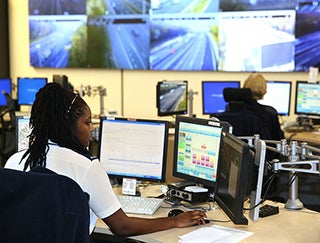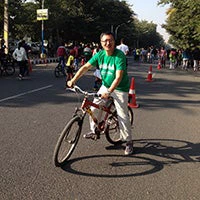Follow the author on Twitter:
@KeFang2002

In many developing cities, transport infrastructure – whether it be roads, metro systems or BRT - is not growing fast enough, and cannot keep up with the ever-increasing demand for urban mobility. Indeed, constructing urban transport infrastructure is both expensive and challenging. First, many cities do not yet have the capacity to mobilize the large amount of funds needed to finance infrastructure projects. Second, planning and implementing urban transport infrastructure projects is tough, especially in dense urban areas where land acquisition and resettlement issues can be extremely complex. As a result, delays in project implementation are the norm in many places.
Therefore, solving urgent urban transport problems in these cities requires us to think outside the box. Fortunately, the rapid development of ICT-enabled approaches provides a great opportunity to optimize and enhance the efficiency of existing and new urban transport systems, at a cost much lower than building new infrastructure from the ground up.

In many developing cities, transport infrastructure – whether it be roads, metro systems or BRT - is not growing fast enough, and cannot keep up with the ever-increasing demand for urban mobility. Indeed, constructing urban transport infrastructure is both expensive and challenging. First, many cities do not yet have the capacity to mobilize the large amount of funds needed to finance infrastructure projects. Second, planning and implementing urban transport infrastructure projects is tough, especially in dense urban areas where land acquisition and resettlement issues can be extremely complex. As a result, delays in project implementation are the norm in many places.
Therefore, solving urgent urban transport problems in these cities requires us to think outside the box. Fortunately, the rapid development of ICT-enabled approaches provides a great opportunity to optimize and enhance the efficiency of existing and new urban transport systems, at a cost much lower than building new infrastructure from the ground up.
- Intelligent Transport Systems, such as Area Traffic Control, which can automatically adjust traffic signal timings within a large urban area based on real time traffic information, Bus Priority Signals, Computer-aided Bus Dispatch, and Real Time Passenger Information, which can significantly improve the capacity and quality of existing bus services.
- Open-data/open-source transport applications that have been used, for instance, in Boston, New York, Mexico City, and Manila to visualize public transport accessibility, design and simulate bikeshare systems, collect public transport routing data, provide real time alternate travel route information, monitor and record road safety data, and carry out travel time surveys. These applications can enable small stakeholders such as municipal governments and civil society to access modern planning tools and to improve communications and operations at very low cost. More importantly, they could create a low-cost digital infrastructure that has the potential to transform urban mobility in the future.
- ‘Big data’ analytics, and data mining/optimization/pattern recognition-based approaches that are being used for identifying flood risks, understanding women’s travel needs and concerns, managing traffic, and nudging behavior change. For example, the Indian IT company InfoSys piloted an ICT-supported incentive project in 2008 to encourage its employees to travel to its suburban campus at different times, significantly reducing congestion during the morning peak hours. Similar tools are now being used in New York and by the Singapore metro system to voluntarily shift travel demand from peak to non-peak hours. These initiatives can lead to huge financial savings by reducing the need for costly investments like additional roads (in the case of New York) or trains (in Singapore).
- Citizen engagement and bottom-up crowd-sourcing approaches which have been used successfully in disaster response, public communication, grievance redress and governance and accountability mechanisms. As an illustration, crowdsourcing platform Ushahidi was used in Washington DC and New York to map snow clean up efforts after storms. This type of platform can be used in cities to engage communities and citizens in all kinds of activities that address both the supply and demand side of transport services, including: monitoring road construction and maintenance, reporting traffic accidents and safety/security concerns, reducing illegal occupancy on sidewalks and bus/bicycle lanes, sharing vehicles with others, using vehicles based on demand, shifting from personal vehicles to public transport, etc.


Join the Conversation